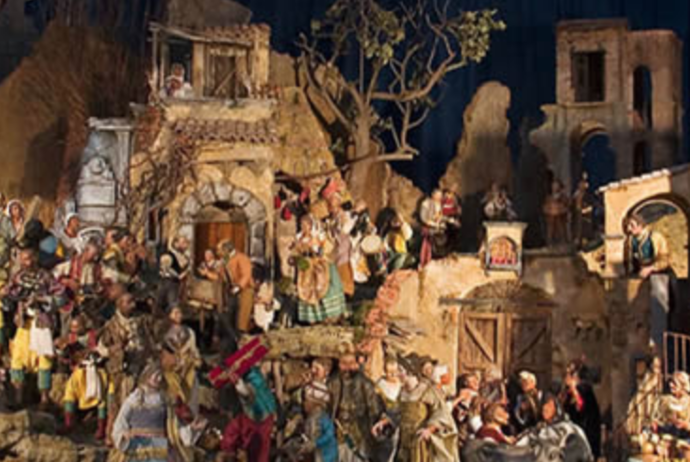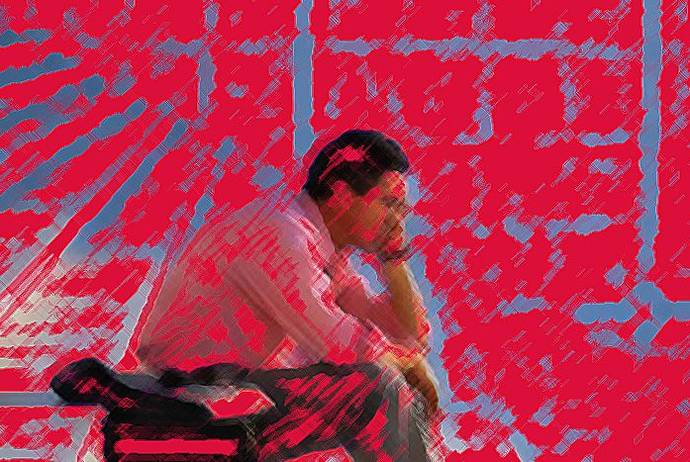The nativity is ready. I always make one in my studio. The terracotta figurines keep me company and kindle my excitement for Christmas Eve. Alone at the computer,
I go about writing the usual greetings. The rare sound of bagpipes takes me back to my childhood Christmases, that long-gone time when, with a shaky hand, I wrote letters to baby Jesus, simple as an infant’s: “Dear Jesus…”
I would hide the letter under my father’s plate on Christmas Eve and every year he would feign innocence, open his eyes wide and say: “I wonder who’s written me?” I wrote my letters in sky blue ink, blue as the evening, and gold glitter, like stars, streamed down the page. In the center of the page was a picture of the nativity: Mary and Joseph, the baby in his cradle, the faint silhouette of the oxen and ass.
In our neck of the woods, the nativity set the tone of anticipation that brought families closer together. Grandparents and grandchildren would prepare for the big event, the birth of the divine child at the heart of the story. All the tradition called for was a little cork, wire, glue made with water and flour, fresh moss giving off the scent of Christmas and those terracotta figurines – the shepherds – handled with care and representing the enchantment of that holy night. Every year was thrilling; united in this simple task, the family unwrapped the shepherds and slowly savored the holiday, day by day. Christmas in our house began in November and ended in January.
Of course, the real date for celebration, the day baby Jesus was born, is December 25th. But Christmas, for those making a nativity, isn’t an event you consume in a day; the holiday doesn’t last just a few hours. You patiently wait for it, assembling your cave, in eager anticipation and enjoyment of the day, looking forward to celebrating it for years to come. You savor the holiday season like a rare, exquisite dish, slowly, without rushing ahead.
Christmas in Naples opens and closes, like a curtain on a large stage. Opening and closing describe the physical act of a period’s inauguration and conclusion. It opens and closes like life, like a concerto, like a speech.
It’s like unwrapping the shepherds that have been carefully tucked away in a box, tied with an old string and stored in a closet all year. And while unwrapping them, adults share the story behind all the excitement, explaining to the youngest members of the family what each figurine stands for, passing on the profound meaning of the Gospel without the book itself. Far from the scholasticism of official theology, the nativity can communicate the joy of salvation even to those who continue to celebrate Christmas without every knowing why.
The Neapolitan nativity, now as then, goes beyond religion. It shows a world of cultural symbols that people unconsciously make while piously building their nativity, connecting their need for God and their attachment to home with their own corner of the world.
A cultural relic, the nativity includes figurines that in ancient times, in every house, linked the dead to the living. It was seen as a form of magical protection, still extant in many parts of the world, like talismans placed outside their homes to ward off evil.
In fact, myth, symbol and tradition associated with the nativity form a group of stories that safeguards the tradition of a people, conveying the unresolved assimilation of a new cult to a preexisting civilization. The Neapolitan nativity is, therefore, the Word made flesh, wedded to the myths, fables, stories and splendors of a culture that continues to preserve the past, even in the years of Christianity.
One thing is certain about the Neapolitan nativity: the Baby Jesus, independent of his actual date of his birth, is reborn every day.
From the 1700s on, our Nativity combines the history of salvation with the history of Naples. From Pulcinella to Masaniello, from Eduardo to Totò, from Maradona to the politicians of the day, everyone in the city is accounted for in the nativity scene at San Gregorio Armeno. And thanks to this identification of our day-to-day lives with God, the deeper meaning of the New Testament shines through in the Neapolitan nativity, where, whether right or wrong, the sacred and profane, the past and present, history and legend fuse together. Sure, to understand the nativity you need to make the same journey the “shepherd of the miracle” makes. Once inside the cave, the shepherd stands with his mouth agape, like all the people stunned stiff by the miracle of the divine baby reborn year after year.
Old tradition that it is, the nativity scene still prophecies the future. A family gathered together to assemble a presepio is a challenge to a world in crisis, the simple announcement of the dawn of a new humanity.
Mons. Don Gennaro Matino teaches Theology and History of Christianity in Naples, where he runs the parish of SS. Trinità. He has written several books and essays, and collaborates extensively with both traditional and new media

































